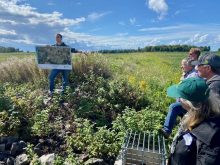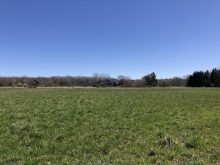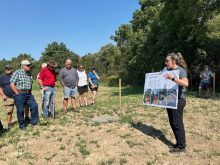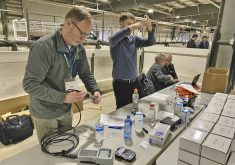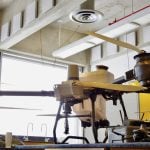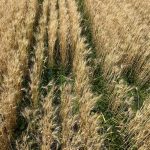What if farmers could collect field drainage and rainfall to supply the right amount of water at the right time for crop production and improve water quality in the process?
That dream is closer to reality for Iowa farmers through emerging technology of drainage water recycling on several farms.
Precipitation in Iowa is generally adequate to produce good crops. However, yields are often limited when the timing and volume of rainfall doesn’t coincide with crop water needs.
Read Also

The forced Japanese-Canadian farmers of the Second World War
Manitoba’s sugar beet farms drew on displaced Japanese-Canadians from B.C. during the Second World War
By storing drainage water in spring to reuse in summer as supplemental irrigation during dry periods, drainage water recycling can increase crop yields and make cropping systems more predictable and resilient to weather extremes.
A new report, Drainage Recycling for Crop Production and Water Quality in Iowa, is available on the Iowa Soybean Association website. It’s authored by consultant Chris Hay, formerly with the association, and Matt Helmers, professor of agricultural and biosystems engineering at Iowa State University and director of the Iowa Nutrient Research Center.
The report reviews information from seven sites across the Midwest and adds new findings from three drainage water recycling systems in Iowa. One was installed in 2022 by Kellie and A.J. Blair on their corn and soybean farm near Dayton. There, a corner of a field was excavated to create a small reservoir that can irrigate about 106 acres of adjacent farmland.
“We are already experiencing more unstable weather and know this may become a greater concern in the future, so we wanted to be prepared,” Kellie said.
Water quality
Improving water quality was another reason the Blairs invested in the system, Kellie said.
Drainage water recycling systems can capture excess nitrogen and phosphorus from fields that would otherwise flow downstream. Storage in a reservoir can reduce nutrient concentrations and recycle them back to fields with irrigation.
Depending on how systems and the land surrounding them are designed and managed, they may also provide additional benefits, such as habitat for migrating waterfowl.
Four site-years of monitoring in Iowa showed dramatic reductions in nitrogen, ranging from 92 per cent at the Dayton site to 63 per cent at the Lake City location.
At the latter site, where more water flows through the system, higher total loads of nitrogen were treated despite the smaller percentage reduction.
Generally, phosphorus was reduced as well, though the story there was more complicated. At Lake City, the 2022 data showed that phosphorus increased in water flowing back to the stream, yet in the next year, phosphorus loss decreased. These results are a focus of continued research, according to the authors.
Benefits and costs
The systems are not cheap or suitable for every situation. They usually require new underground drainage lines in fields and some type of irrigation equipment. Most locations will also need excavation for a reservoir. If a stream will be affected, environmental permits and assessments may be required.
Yields from irrigated portions of fields with drainage water systems were consistently greater than from rain-fed areas. The site in Iowa with the longest production record showed corn yields improved by about 35 bu./acre on average.
Helmers said drainage water recycling is not a new practice. Early research in Iowa from the late 1980s and 1990s showed the systems have promise, “but due to the costs, it was suggested that the greatest potential for the practice was for high value crops or areas where there were significant water quality concerns.”
Hay agrees.
“There are still unanswered questions before we can recommend scaling up. They include getting a better understanding of likely long-term payoffs. Even so, the new report provides more evidence that these systems can deliver win-win-wins for production and environmental benefits that we don’t always have.”





